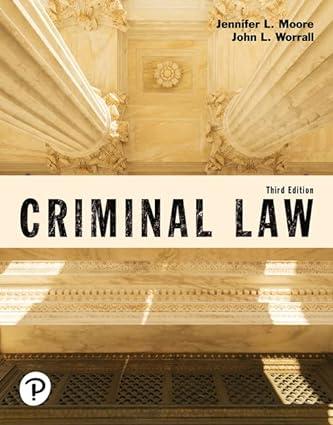Question
choose a case from your state that involves civil rights or civil liberties that was decided by the United States Supreme Court. If your state
choose a case from your state that involves civil rights or civil liberties that was decided by the United States Supreme Court. If your state does not have a case that was decided by the United States Supreme Court, choose a civil rights case from another state for which the United States Supreme Court issued a decision.
Here is a brief description of civil rights and civil liberties: Civil rights refers to equal social opportunities under the law. It gives you these freedoms such as the right to vote, the right to public education, or a fair trial, among other things, regardless of your wealth or race. Civil liberties mean freedom of religion, equal treatment and due process under the law, and the right to privacy.
You should be able to go online and look up your state and famous cases decided by the Supreme Court. For example, Brown v Board of Education (1951) started in Topeka, Kansas, and ended up in the Supreme Court of the United States. Another example would be Calvary Chapel Dayton Valley v Steve Sisolak, Governor of Nevada (2020) that started in Nevada and ended up the United States Supreme Court. A good source of information about cases decided by the United States Supreme Court is www.scotusblog.com. Other sources can be researched online using search terms for "civil rights cases decided by the U.S. Supreme Court." Be sure to use a case actually decided by the United States Supreme Court, and not a case decided by your state's supreme court or a different court. A case that is still pending before the United States Supreme Court should not be used. If you are unsure, please contact your Professor BEFORE you pick your case and submit the assignment as this is a significant part of your overall grade.
Summary of the Case
In one or two paragraphs, provide a general overview of the case that serves as a snapshot of what the case is about and how it ended up in your state high court. A summary is using your words to write a brief history of the case. Do not give your opinion or your interpretation but stick to the facts only.
Case Outline
Your court case outline should include:
Title: Name of the case
Facts of the case: Provide key facts involving the case.
History of the case: What legal action was taken based on what your state laws say about this case?
Legal questions: What were the legal issues the court had to decide?
Decision or holdings: Did the court decide for the plaintiff or the defendant? Explain the reason behind the decision?
Verdict and opinion (judgement): What were the concurring and dissenting opinions? How many judges decided for the defendant and how many justices decided against the defendant? What was the final verdict from the judge or the jury, if it was a jury trial?
Conclusion:
What was the resulting impact of the ruling? How did the citizens of your state benefit from it? Was this a good decision?
Step by Step Solution
3.46 Rating (156 Votes )
There are 3 Steps involved in it
Step: 1
ANSWER Title Brown v Board of Education of Topeka 1954 Summary of the Case Brown v Board of Education was a landmark case in the United States Supreme ...
Get Instant Access to Expert-Tailored Solutions
See step-by-step solutions with expert insights and AI powered tools for academic success
Step: 2

Step: 3

Ace Your Homework with AI
Get the answers you need in no time with our AI-driven, step-by-step assistance
Get Started


